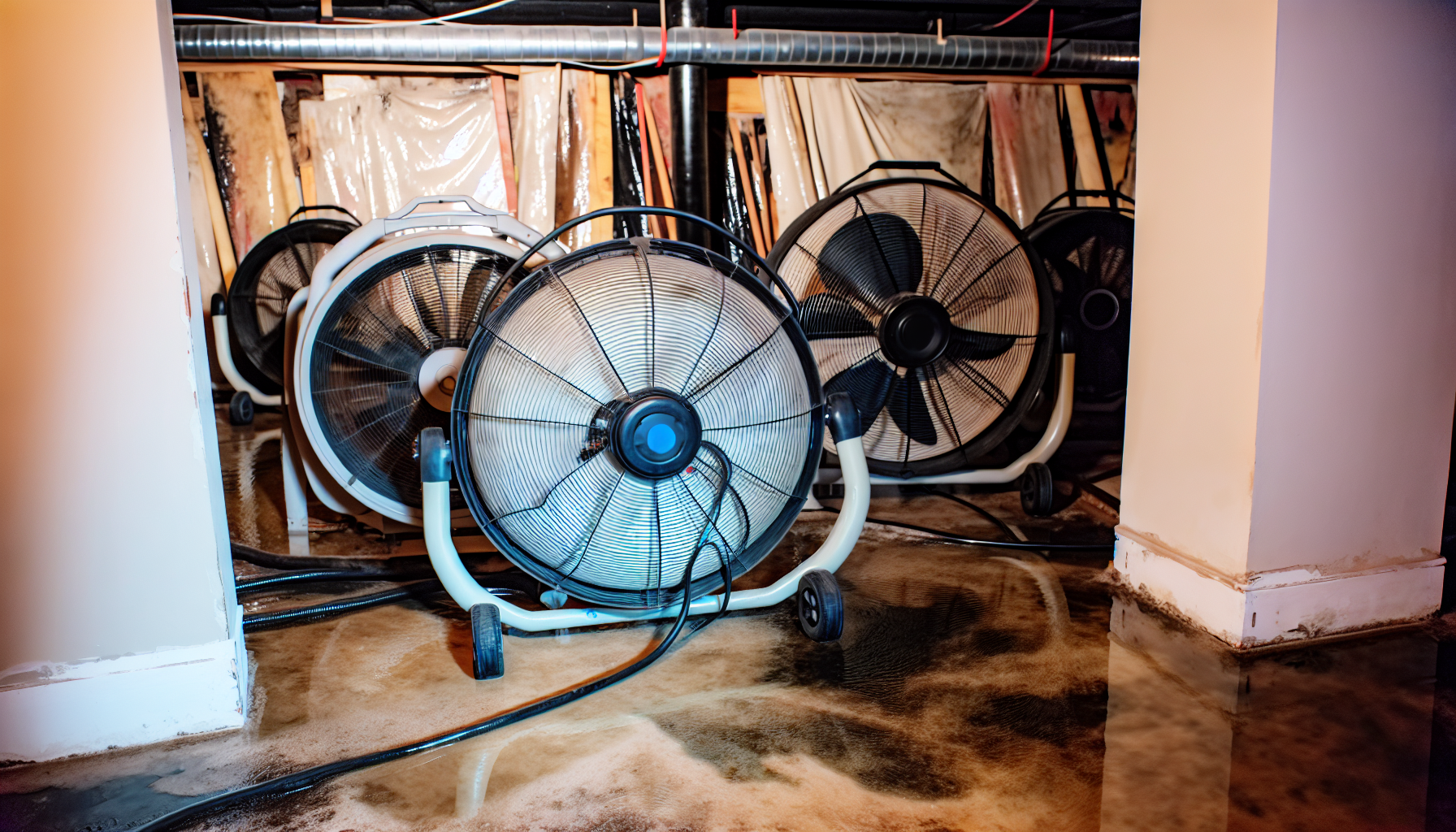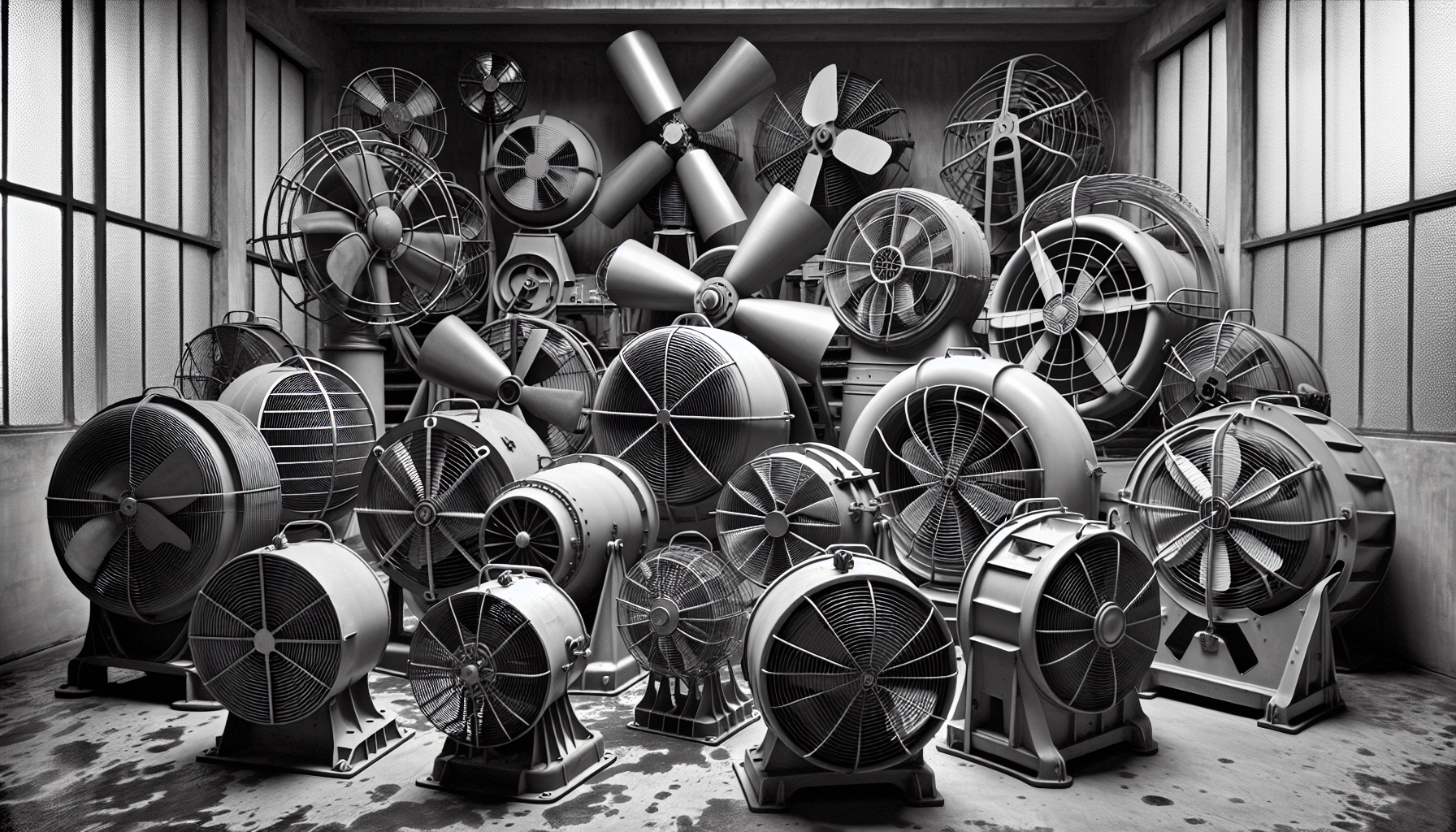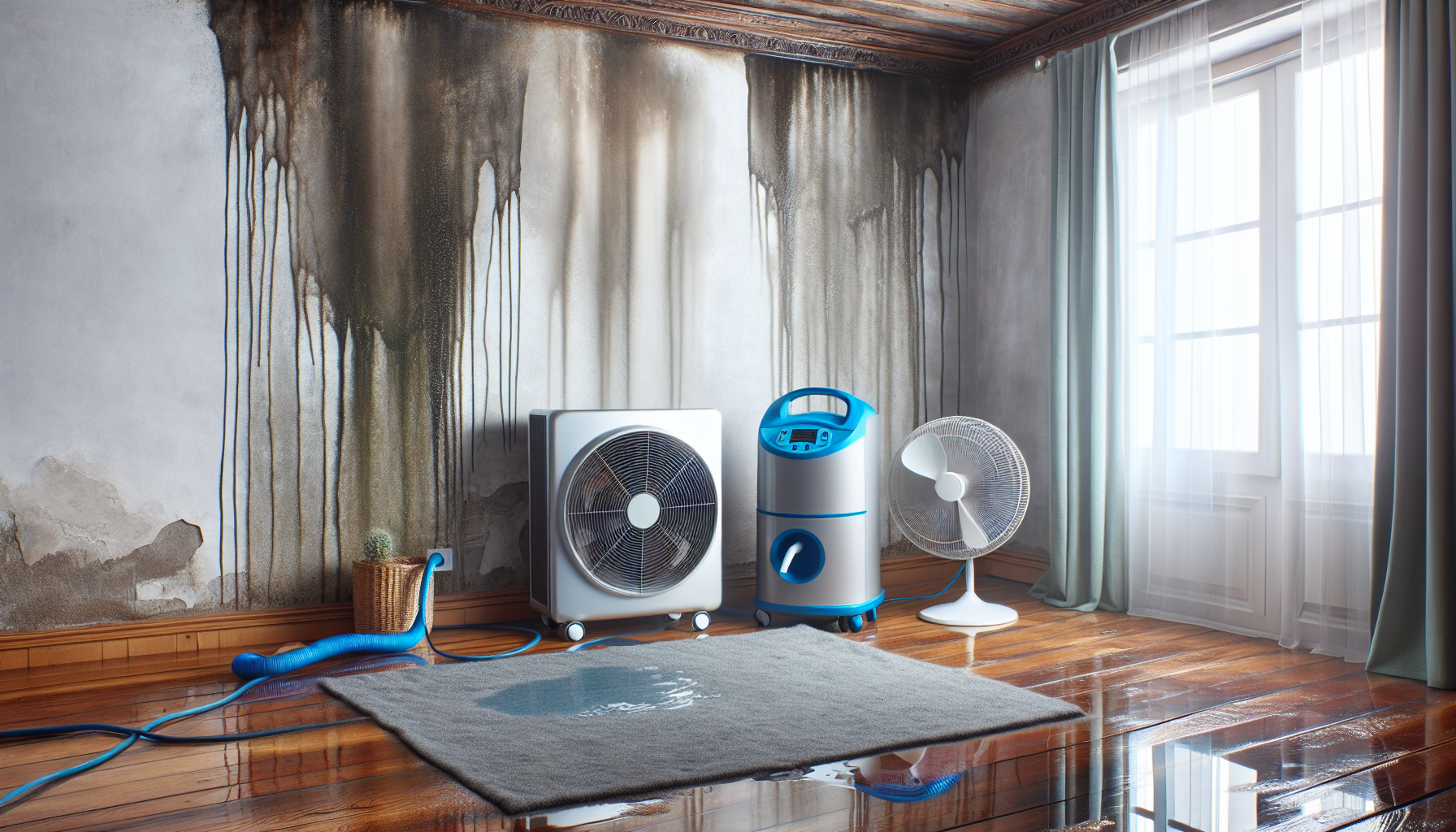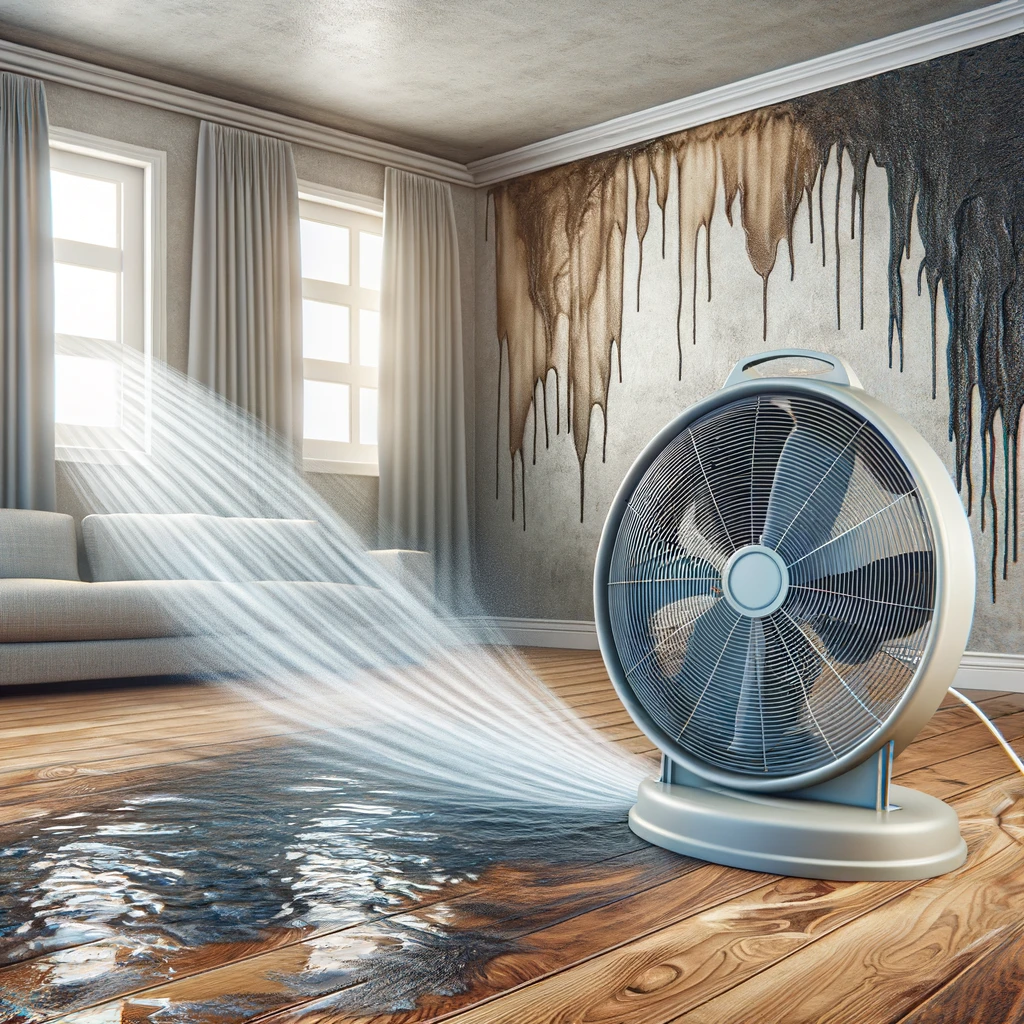Dealing with water damage can be overwhelming, but you might be wondering, do fans help with water damage? The answer is yes. Fans are essential for promoting fast drying and mitigating mold growth after a water incident. In this article, we will discuss how fans contribute to water damage restoration and cover effective usage, fan selection, and when to call in professionals.
Key Takeaways
-
Fans and air movers are essential in water damage restoration for enhancing air circulation, accelerating the drying process, and preventing mold growth, with the general recommendation of running them continuously for the first 24 to 48 hours and then monitoring and adjusting as needed depending on various factors like severity and materials affected.
-
Choosing the appropriate type and placement of industrial-grade fans and air movers is crucial to maximize efficiency in water damage restoration, with axial air movers being ideal for open spaces and centrifugal air movers being suited for areas requiring high-pressure air movement.
-
Professional assistance in water damage restoration becomes necessary in severe cases involving structural damage, health hazards such as mold and pathogens, or when special equipment and techniques are required; such circumstances also demand a deep understanding of insurance coverage and the ability to effectively navigate the claims process.
The Role of Fans in Water Damage Restoration

When water damage strikes, time is of the essence. And that’s where fans after water damage come into play. Fans are a lifeline in water damage restoration, making them a household essential in the wake of a water disaster. They promote air circulation, speeding up the drying process, and preventing mold growth, thereby minimizing the impact of the water damage.
If you’re dealing with water damage, you may be unsure how long to run fans for. It’s important to follow the recommended guidelines for effective drying and preventing further damage. Here are some general guidelines to consider:
-
The first 24-48 hours of continuous operation is typically beneficial.
-
Ongoing monitoring and adjustments are essential.
-
The severity of the damage, type of materials affected, and humidity level all affect the duration of fan operation.
Air Circulation
Proper air circulation is the silent hero in the fight against water damage. It enhances the evaporation rate, thereby accelerating the drying process. To increase air circulation, it’s not just about switching on a fan and leaving it to do its job. The type, settings, and locations of air movers may require adjustments to optimize the drying process.
Consider this: for larger rooms, you may need one air mover per room, and additional air movers depending on the square footage of the wet floor and affected upper walls and ceiling. This strategy ensures the moisture-laden air is effectively circulated throughout the space, preventing the onset of further damage.
Accelerating the Drying Process
Fans are like superheroes speeding to the rescue in the world of water damage restoration. They turbocharge the evaporation process and dry out water-damaged materials, making them essential players in the restoration scenario. Industrial-grade air movers, for instance, provide high-velocity airflow, making them ideal for restoration scenarios.
The key to effectively dry out water-damaged areas is to run fans for at least 24 to 48 hours after water damage signs disappear. However, remember that the success of fans in accelerating drying can vary based on the type of water event, affected materials, and the volume of water involved.
Preventing Mold Growth
When it comes to water damage, mold growth is a silent enemy that can creep up within 24-48 hours if excess moisture is not promptly addressed. Excess moisture is the perfect breeding ground for mold, posing potential health problems. But worry not, good airflow can come to the rescue, drying wet areas quickly and curtailing the moisture that facilitates mold growth.
The key lies in ensuring proper air circulation, which is where fans and air movers play an integral role. By maintaining low moisture levels, they help prevent the onset of mold growth, ensuring your living environment remains safe and healthy.
Selecting the Right Fan for the Job

Not all fans are created equal, especially when it comes to water damage restoration. Choosing the right fan for the job is critical. It involves considering factors like fan type and power, along with proper placement for optimal air circulation.
There are two main types of industrial-grade fans used in water damage restoration: axial blade and centrifugal wheel air movers. While axial air movers are better suited for larger, open spaces, centrifugal air movers are ideal for applications requiring high-pressure air movement, like drying sealed or closed-off areas.
Industrial-Grade Fans
Industrial-grade fans are the superheroes of water damage restoration. Their powerful air movement capabilities make them a game-changer in the drying process. Designed for frequent and long-term use, these fans deliver consistent performance, ensuring a reliable restoration process.
These fans are not just about power; they’re also about durability. Industrial-grade fans are built to weather the storm, quite literally. They’re robust and designed for heavy-duty use, making them the go-to choice for professional water damage restoration.
Air Movers
Air movers play a pivotal role in water damage restoration. They promote airflow, reducing the time that water is present, thereby minimizing damage. They work by pulling moisture into the air from damp surfaces like floors and carpets.
By increasing the rate of evaporation, air movers enable quicker drying of water-impacted areas, which is central to efficient water damage restoration. The effective and prompt use of air movers is critical in preventing long-term issues such as rot and mold that may arise from prolonged exposure to water.
Proper Placement
Just like a well-placed piece of furniture can enhance a room’s aesthetics, the right placement of a fan can significantly improve the drying process after water damage. Placement is key in ensuring effective drying and optimal air circulation.
For instance, in larger rooms, axial air movers may be necessary for reaching the center, and adjustments should be made to fan type and placement as conditions change. Additionally, fans should be set at least 1 to 2 feet from walls or furniture to improve ventilation and prevent restrictions in air flow.
Choosing the right exhaust fan for mold prevention is equally important, and it depends on the space size, moisture level, and area-specific needs.
When to Seek Professional Assistance
While fans play a crucial role in water damage restoration, there are situations when professional help is necessary. In cases of severe water damage, structural damage, and potential health hazards, it’s imperative to seek professional assistance.
Experts can respond immediately and prevent further harm, ensuring the safety of your home and your health. They have the skills, knowledge, and specialized equipment to handle the restoration process efficiently and effectively. So, when the situation calls for it, don’t hesitate to call in the pros.
Severe Water Damage
Severe water damage in affected areas can result from:
-
natural disasters
-
plumbing issues, including broken pipe
-
roof leaks
-
appliance malfunctions
-
sewage backups
requires the expertise and immediate response of professional restoration services. Experts can prevent the water from spreading and causing further damage, thereby minimizing the overall impact.
In cases of severe water damage involving sewage contamination, specialized equipment like centrifugal air movers and washing machines are necessary for extreme drying power. These machines can handle the heavy-duty work required in such scenarios, ensuring a thorough and efficient restoration process.
Structural Damage
Water damage can cause significant structural issues, compromising the integrity of walls, ceilings, floors, and foundations. Untreated water damage can lead to deteriorating roof decks, softened or warped wood-frame components, and eroding foundations. This is where professional assessments come in handy, identifying and documenting any structural concerns.
Specialized tools like thermo-hygrometers and thermal imaging cameras are used by professionals to ensure the structural integrity of the property is maintained. Prompt professional restoration can mitigate the extent of losses by minimizing potential structural, electrical, and mold-related damages.
Health Hazards
Health hazards stemming from water damage, such as mold growth and exposure to pathogens, are not to be taken lightly. Standing water and prolonged moisture can lead to the growth of bacteria, viruses, and other pathogens, increasing the risk of respiratory issues and allergic reactions.
Exposure to mold can result in conditions like allergic rhinitis, bronchial asthma, and conjunctivitis, especially in individuals with genetic susceptibilities. Therefore, it’s crucial to seek professional help for safe and effective cleanup, as not being properly trained to remove standing water from water-damaged areas poses additional health and safety risks.
Additional Equipment and Techniques for Effective Drying

In addition to fans and air movers, a range of other equipment and techniques can enhance the drying process during water damage restoration. From dehumidifiers that lower humidity levels to advanced drying techniques, the arsenal of tools at your disposal is vast and varied.
These additional measures can be particularly useful in cases of severe water damage, where standard drying procedures might not suffice. The right combination of equipment and techniques can make a world of difference in restoring your home to its pre-damage condition.
Dehumidifiers
Dehumidifiers are like the sidekicks to fans in the battle against water damage. They work alongside fans to lower humidity levels and improve the overall drying efficiency. They remove moisture from hard-to-reach areas and from the air, facilitating the drying process.
Utilizing fans in conjunction with dehumidifiers maximizes moisture extraction. Humidity monitors can be used alongside dehumidifiers to ensure indoor humidity levels remain low, creating an environment that is not conducive to mold growth.
Proper Ventilation
Proper ventilation is a key player in the fight to prevent mold growth. It allows for the exchange of humid, mold-prone air with drier air, ensuring a safer environment in water-damaged spaces.
Differentiated approaches to ventilation, such as natural ventilation through open windows or vents, and mechanical ventilation with fans, are crucial in areas with inherently high humidity levels, like bathrooms and kitchens.
Whole-house ventilation systems offer an effective solution for circulating fresh air and mitigating moisture throughout the entire dwelling, thereby preventing conditions that favor mold proliferation in high humidity zones.
Advanced Drying Techniques
In cases of severe water damage, professionals employ specialized drying techniques alongside standard practices to restore water-damaged materials and spaces effectively. They utilize advanced equipment and techniques like proper ventilation and strategic fan placement to maximize air circulation and accelerate evaporation.
Regular monitoring of humidity levels and removal of wet materials are important steps in the proper drying process to prevent further water damage and mold growth. Advanced drying techniques ensure that every nook and cranny is thoroughly dried, leaving no room for any hidden moisture that could cause damage down the line. By doing so, we effectively eliminate the ability of materials to retain moisture, which is crucial in preventing future issues.
Navigating Insurance Claims for Water Damage Restoration
Water damage restoration can be a costly affair, and that’s where insurance comes in. Understanding your insurance coverage, submitting a claim, and working with professionals can smoothen the insurance process.
Knowing what your insurance policy covers is crucial for determining if water damage restoration processes, including related expenses, are covered. Familiarity with insurance coverage can lead to better outcomes when submitting claims for water damage restoration costs.
Understanding Your Coverage
Understanding the specifics of your insurance policy is crucial when dealing with water damage. Homeowners insurance typically covers sudden or accidental water damage such as burst pipes, accidental leaks, and storm-related damage.
However, it’s worth noting that additional coverage for sewer and drain backups usually requires an additional sewer insurance rider. Also, before filing a claim for water damage, you should review your policy details to understand the deductible amount, which could vary from $500 to $5,000.
Submitting a Claim
Submitting a claim involves the following steps:
-
Contacting your insurance carrier
-
Completing and submitting claim forms
-
Executing temporary repairs to mitigate further damage
-
Compiling the necessary documentation of the damages occurred.
Comprehensive documentation of water damage is crucial for substantiating a claim with the insurance company. After the claim submission, the following steps will typically occur:
-
An insurance adjuster might visit the property to evaluate the damage.
-
The insurance company will provide a repair cost estimate.
-
The insurance company will proceed to issue payment for the covered expenses.
Working with Professionals
Partnering with professional restoration companies provides homeowners with the necessary support during the insurance claim process. These professionals guide homeowners in accurately documenting water damages, a necessary step for filing insurance claims.
Such professional assistance ensures homeowners navigate the insurance claim process more efficiently and helps achieve a fair settlement. They provide the necessary documentation and support, making the insurance claim process less daunting.
Summary
Water damage restoration can seem like a daunting task, but with the right knowledge and tools at your disposal, you can navigate it like a pro. Remember, fans play a crucial role in promoting air circulation, accelerating the drying process, and preventing mold growth. Choosing the right fan and proper placement is key. In severe cases and health hazards, don’t hesitate to seek professional assistance. They not only have the advanced equipment and techniques to handle the restoration process but also provide the necessary support during the insurance claim process. Remember, the quicker you act, the lesser the damage.
Frequently Asked Questions
What kind of fan is used to dry water damage?
To dry water damage, professionals use air movers, which are more efficient and faster than traditional fans at drying an area.
Does a fan get rid of water?
Yes, a fan like a bathroom exhaust fan can effectively remove excess moisture and water vapor from your bathroom. This helps prevent damages caused by water accumulation and maintain dryness in the space.
Will a fan dry up water?
Yes, a fan can help dry up water by promoting enhanced evaporation and speeding up the overall drying process.
How long should you run fans after water damage?
You should run fans continuously for the first 24 to 48 hours after water damage to remove excess moisture and prevent mold growth, especially for materials like drywall and carpet. This initial period is crucial for mitigating the damage caused by water.
When should I seek professional help for water damage restoration?
You should seek professional help for water damage restoration in cases of severe water damage, structural damage, and potential health hazards. Don’t hesitate to contact experts when dealing with these issues.


